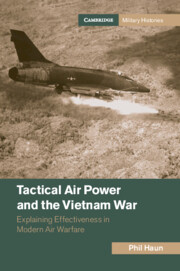Refine search
Actions for selected content:
3 results
15 - Army and Warfare
- from Part II - Contexts
-
-
- Book:
- The Cambridge Companion to Alexander the Great
- Published online:
- 04 January 2024
- Print publication:
- 18 January 2024, pp 243-255
-
- Chapter
- Export citation

Tactical Air Power and the Vietnam War
- Explaining Effectiveness in Modern Air Warfare
-
- Published online:
- 04 January 2024
- Print publication:
- 18 January 2024
7 - Learning
-
- Book:
- Holding Out
- Published online:
- 31 March 2023
- Print publication:
- 20 April 2023, pp 215-244
-
- Chapter
- Export citation
